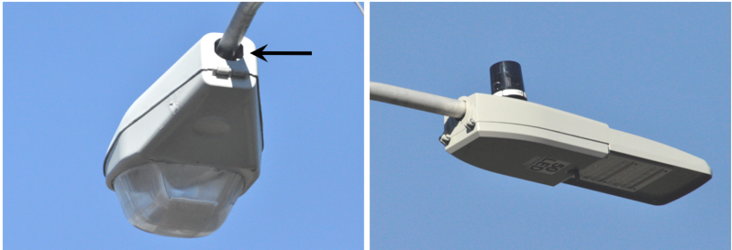Jeffrey Boone Miller

Figure 1. Arrow in left panel points to the opening in an old-style streetlight through which wrens could enter. Right panel shows a new LED streetlight with no opening.
House Wrens (Troglodytes aedon)—the Latin binomial roughly translates as “cave-dwelling nightingale”—regularly make use of nesting sites that are inadvertently provided by their human neighbors. In Birds of America, for example, Audubon painted House Wrens nesting in an old hat, and Bent (1948) noted that “The House Wren stands out preeminently as one of the most eccentric of our birds in the choice of its nesting site.” Here I tell a tale of how House Wrens in my suburban neighborhood of Belmont, Massachusetts, have used streetlights for nesting sites.
In late spring of 2017, I first observed a pair of House Wrens nesting and raising chicks in a streetlight housing. At that time, all of the streetlights in our neighborhood had openings in the back of the housing that were just big enough for small birds to enter (arrow in Figure 1, left panel). I had seen House Sparrows nesting in this same light in the summer of 2016, which is consistent with the tendency of House Wrens to reuse cavities first occupied by other species (Sedgwick 1997, Johnson 2020). In 2018 and 2019, I found single pairs of House Wrens nesting in nearby streetlights, and in 2020, during my longer, Covid-19-enforced walks, I found four pairs of wrens with active nests in streetlights, including one pair in the light where I had first seen wrens in 2017. Four pairs seemed to constitute a phenomenon, so I started to pay more attention.
In May and June 2020, each of the four nests was consistently attended by at least one noisy wren. As the season progressed, I began to hear the peeping of nestlings. Of the four nests, the closest were separated by about 250 feet—as the wren flies—and the most distant were about 750 feet apart. All four nests fit within a 1,000-foot diameter circle. Though inter-nest distances and territory sizes depend on the number of possible nest sites and food availability, the spacing I noted was consistent with studies showing that House Wrens tend to nest more than 100 feet apart and to defend territories on the order of 100 to 200 feet in diameter (Johnson 2020). Two of the nests faced east, one south, and one west, indicating little directional preference.
What made the streetlights attractive as nest sites? House Wrens are cavity nesters—hence Troglodytes—and the streetlights appeared to be a good substitute for a natural cavity. The housings provided room enough for a nest, protection from wind and rain, a defensible access point, and, I would guess, nighttime warmth when the lights were turned on. Because I observed fledglings, temperatures must not have exceeded the maximum compatible with egg development, which is in the range of 95–105°F (Johnson 2020). The birds also had to tolerate disruption of the natural light cycle.
As I observed these nests, questions came to mind. For example, because males often start to construct multiple nests in their territory before pairing with a female (Johnson 2020), had the males started nests in multiple lights? If given a choice, would females prefer streetlights over other, perhaps more natural, nest sites? Had the birds occupying the four streetlights in 2020 been themselves raised in streetlights? Were these birds genetically related, or did newcomers to the neighborhood also discover the streetlights? Were there other localities with such streetlight nests, or was this phenomenon unique to my neighborhood? Did the birds learn from each other that the lights were suitable nest sites? I began to envision an extensive research project.
On a morning in mid-August of 2020, with these questions still unanswered, I found another streetlight occupied by a pair of House Wrens and—judging by the constant peeping—their youngsters. House Wrens can produce two broods in a season (Johnson 2020), so a nest with chicks in August was not unexpected. I resolved to return the next day with my camera to document this late nest. As I walked home that morning, I noticed a crew from Belmont Municipal Light working on a streetlight. I didn’t think much of it at the time, but when I returned the next afternoon, camera in hand, I discovered that the crew’s activities had been disastrous for the wrens.
Belmont Light had chosen those days to replace the old-style streetlights—including the one with the active wren’s nest—with new LED light fixtures. I found that the old light, the wrens, and their nestlings were gone, replaced by an LED housing that did not have an opening (Figure 1, right panel), thereby eliminating any possibility of future nests. What a difference a day can make.
In coming years, I’ll continue to look for House Wrens nesting in odd locations. The utility left behind a few of the old-style lights, mostly on busy streets, so perhaps wrens will find those. Although I wish the changeover to LEDs had been delayed a few days until the nestlings fledged, the new lights use much less energy and are noticeably brighter, so I cannot argue with the decision to install them. It is clear, however, that the proclivity of House Wrens to use human structures for nesting comes with an all-too-familiar drawback—human desires are likely to come first.
References
- Bent, A. C. 1948. Life Histories of North American Nuthatches, Wrens, Thrashers, and Their Allies: Order Passeriformes. United States National Museum. Bulletin 195:113–140. Washington, DC: Smithsonian Institution. https://doi.org/10.5479/si.03629236.195.1
- Johnson, L. S. (2020). House Wren (Troglodytes aedon), version 1.0. In Birds of the World (A. F. Poole, Editor). Cornell Lab of Ornithology, Ithaca, NY, USA. https://doi.org/10.2173/bow.houwre.01 Accessed December 30, 2020.
- Sedgwick, J. A. 1997. Sequential cavity use in a cottonwood bottomland, The Condor 99:880–887.